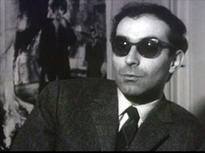1. THE MISE-EN-SCÈNE OF DIRECT ADDRESS II
SCREENING
In the beginning of the 1990s, during the Gulf war, the French film critic Serge Daney proposed a clearcut distinction between the image (“l’image”) and the visual (“le visuel”). The image, to quote Godard “is an encounter between two forces”. If this encounter has become impossible, because of the loss of the referent – the daily flow of images on television, for instance – then the visual is all that remains. The discrete, specific image always refers to something outside itself, something ‘different’. Curator Tanya Leighton adopts this distinction as a starting point for a selection of film and video work, which seeks to challenge and destabilise the dominant model of the visual.
The filmmakers establish themselves with wideranging strategies of dislocation and disruption to question the status of the image in a media-saturated information regime, demonstrating fierce resistance to any form of synthesis. Their work embraces the unpredictable and the volte-face of the notion of the visual, by consciously seeking gaps and fissures. Directors such as Avi Mograbi and Walid Ra’ad create fictional-critical instruments – organisations, characters or aliases – in order to create new understandings of the image. Marc Robinson, Jeremy Deller and Mike Figgis create room for reinterpretation by reconstructing images or engaging in ‘re-enactment’ strategies. Jose Alejandro Restrepo and Keith Sandborn base themselves on detachment and the dismantling of images to create new dialogues. François Bucher and Alexander Kluge each try to rescue the institutionally encapsulated image of television and cinema from insignificance.
These video and filmmakers understand the impossibility of images as signifiers. They recognize the importance of the image as a means to create awareness, accentuating the need to break through the contemporary media spectacle, to disrupt the visual, elevate thinking patterns and look for a new ecology of the image.
The filmmakers establish themselves with wideranging strategies of dislocation and disruption to question the status of the image in a media-saturated information regime, demonstrating fierce resistance to any form of synthesis. Their work embraces the unpredictable and the volte-face of the notion of the visual, by consciously seeking gaps and fissures. Directors such as Avi Mograbi and Walid Ra’ad create fictional-critical instruments – organisations, characters or aliases – in order to create new understandings of the image. Marc Robinson, Jeremy Deller and Mike Figgis create room for reinterpretation by reconstructing images or engaging in ‘re-enactment’ strategies. Jose Alejandro Restrepo and Keith Sandborn base themselves on detachment and the dismantling of images to create new dialogues. François Bucher and Alexander Kluge each try to rescue the institutionally encapsulated image of television and cinema from insignificance.
These video and filmmakers understand the impossibility of images as signifiers. They recognize the importance of the image as a means to create awareness, accentuating the need to break through the contemporary media spectacle, to disrupt the visual, elevate thinking patterns and look for a new ecology of the image.
This event is part of Tanya Leighton - In The Poem About Love You Don’t Write The Word Love

-
Fri 14.10.2005
- Thu 20.10.2005
-
Practical info
Location:
Filmmuseum
Ex Shell-Building
Ravensteinstr. 60
1000 Brussel